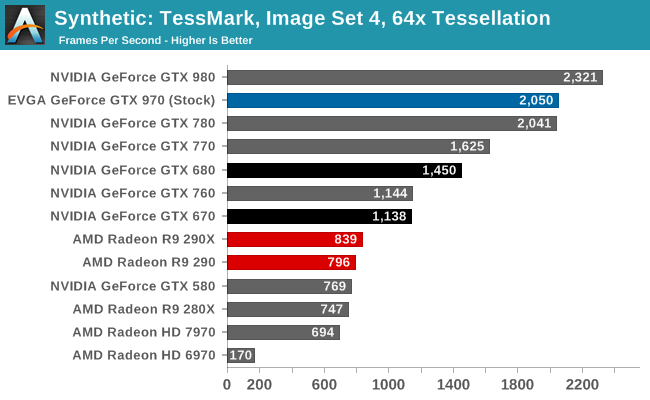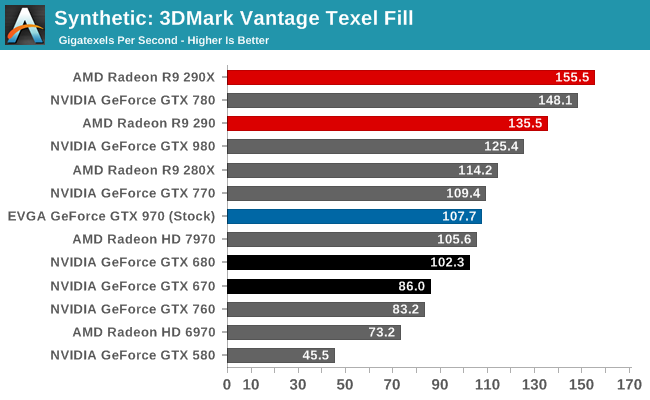The NVIDIA GeForce GTX 970 Review: Featuring EVGA
by Ryan Smith on September 26, 2014 10:00 AM ESTSynthetics
As always we’ll also take a quick look at synthetic performance. These tests mainly serve as a canary for finding important architectural and configuration changes.

Tessellation performance has scaled very closely with the change in SMMs and clock speeds, just as we would expect here.

Texel throughput has also taken a hit in accordance with the loss of SMMs and clock speed. Based on gaming performance the GTX 970 doesn’t appear to be too badly handicapped here, but it definitely doesn’t have much in the way of texel throughput to spare.

Pixel throughput on the other hand ends up being extremely odd and not at all what we were expecting. The GTX 970 takes an incredible dive here, with its pixel fillrate dropping by 26%. At a high level this test is bounded by memory bandwidth and ROP throughput, and both of these factors should be identical between GTX 980 and GTX 970. Instead we see GTX 970 lose more performance than should theoretically be possible, as the 26% drop is more than the accumulated difference between the clock speed and SMM differences.
At this point we’re still trying to figure out exactly what’s going on. We have no other evidence that there’s a difference in ROP throughput or memory bandwidth between the GTX 980 and GTX 970 so it is not clear to us where the difference lies. One possibility is that this is somehow bottlenecked at the Raster Engine level – where each of the four engines accounts for 25% of the work – but the pigeonhole principle means that NVIDIA can’t disable a GPC since at least 1 SMM must be active in each GPC partition. This matter will require further research.










155 Comments
View All Comments
dj christian - Friday, September 26, 2014 - link
What type of fans does it use? Ball bearing or sleeve bearing?bardolious - Friday, September 26, 2014 - link
EVGA uses double ball bearing fans. That's where the extra noise comes from. Much noisier at idle but far more durable. I've really been pleased with the ACX cooler on my 770.Chloiber - Sunday, September 28, 2014 - link
Actually, the noisy ACX on my 770 is the reason I won't be buying another EVGA anytime soon. They have given me a silent BIOS, which is great, but the ACX is still by far the loudest noise maker in my PC. It has also been proven by countless reviews: the idle and even load noise levels were higher than those of the stock GTX 770. And they are making the same mistake AGAIN - I really can't believe it.Well, they seem to come around after seeing all the competitors which seem to understand what it means to deliver silent cards.
The ACX cooler isn't bad, it's actually rather good - the only problem is that they never understood what a "silent" card means. They were always going for lower temperature over lower noise levels - even in idle, which made absolutely no sense.
Iketh - Monday, September 29, 2014 - link
enjoy the other brands' fans going out in 1-2 yearsalso if you read the article (updated 9/26, two days before your post), evga is releasing a passive idle bios which makes your whole post pointless
creed3020 - Friday, September 26, 2014 - link
In all honesty I cannot see how comparing a _reference_ R9 290X on Uber to this particular 970 is valid.We really need a similar open air cooled R9 290X to really see how power, temps, and noise compare....Everyone knows that AMD's reference blower for the 290X just isn't up to the task of cooling that beast.
haukionkannel - Friday, September 26, 2014 - link
True. The R9 290 reference cooler is one of the worst options to chose and non reference has been much better! But still 970 is hard nail in 290X skin!Lithium - Friday, September 26, 2014 - link
YepBut reference 290X still selling and used to make price as low as 449$.
So its valid
creed3020 - Monday, September 29, 2014 - link
Good point. I guess some manufacturers just want that entry product in their stack of offerings and go with the reference design.Thanks Ryan for the hard work on the nVidia 980/970 release, these articles were excellent. In the future perhaps consider a followup test comparing a bunch of cards to more so evaluate their coolers and OC potential. That could be very interesting taking some of the top and mid cards from each manufacturer and doing a quantitative analysis across the board.
AkibWasi - Friday, September 26, 2014 - link
970 has 52 FP64 cuda cores right ? why block diagram doesn't show those ?Ryan Smith - Friday, September 26, 2014 - link
NVIDIA does not include the FP64 CUDA cores in their diagrams for consumer chips. This has been the case as far back as GK104.